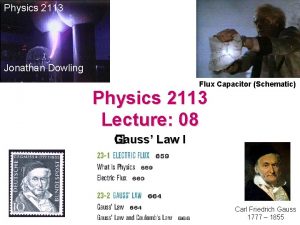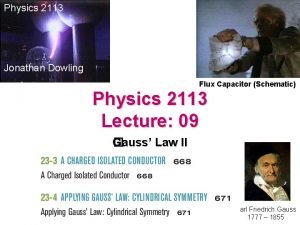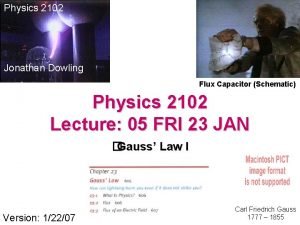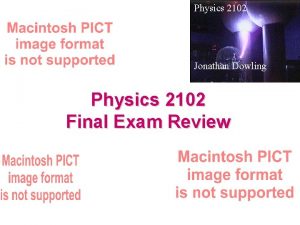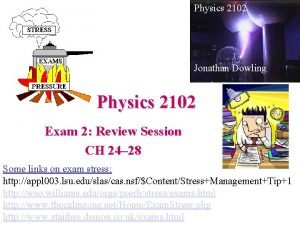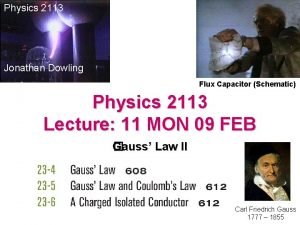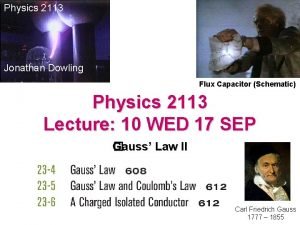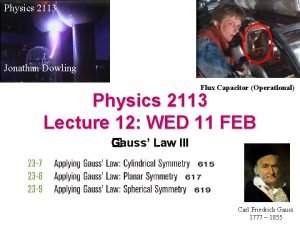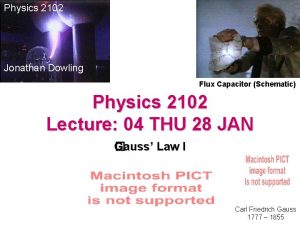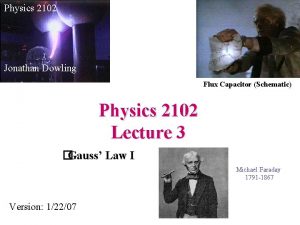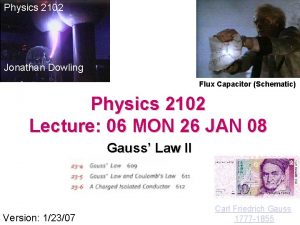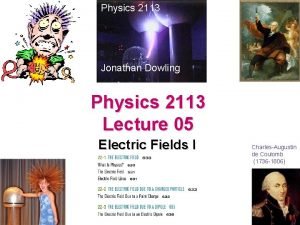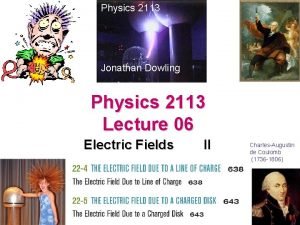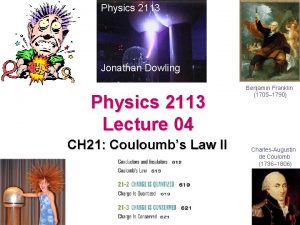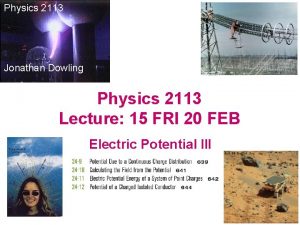Physics 2113 Jonathan Dowling Flux Capacitor Schematic Physics














- Slides: 14

Physics 2113 Jonathan Dowling Flux Capacitor (Schematic) Physics 2113 Lecture: 09 MON 15 SEP Gauss � Gauss’ Law I Carl Friedrich Gauss 1777 – 1855

What Are We Going to Learn? A Road Map • Electric charge - Electric force on other electric charges - Electric field, and electric potential • Moving electric charges : current • Electronic circuit components: batteries, resistors, capacitors • Electric currents - Magnetic field - Magnetic force on moving charges • Time-varying magnetic field - Electric Field • More circuit components: inductors. • Electromagnetic waves - light waves • Geometrical Optics (light rays). • Physical optics (light waves)

What? — The Flux! STRONG E-Field Angle Matters Too Weak E-Field θ d. A Number of E-Lines Through Differential Area “d. A” is a Measure of Strength

Electric Field & Force Law Depends on Geometry Point of Charge: Field Spreads in 3 D Like Inverse Area of Sphere = 1/(4πr 2) Line of Charge: Field Spreads in 2 D Like Inverse Circumference of Circle = 1/(2πr) Sheet of Charge: Field Spreads in 1 D Like A Constant — Does Not Spread!

Electric Flux: Planar Surface • Given: E – planar surface, area A – uniform field E – E makes angle θ with NORMAL to plane • Electric Flux: Φ = E • A = E A cos θ • Units: Nm 2/C • Visualize: “Flow of Wind” Through “Window” θ normal AREA = A=An

Electric Flux: The General Case Air Flow Analogy


Electric Flux: ICPP • Closed cylinder of length L, radius R • Uniform E parallel to cylinder axis • What is the total electric flux through surface of cylinder? (a) (2πRL)E (b) 2(πR 2)E (c) Zero (πR 2)E–(πR 2)E=0 What goes in — MUST come out! Hint! Surface area of sides of cylinder: 2πRL Surface area of top and bottom caps (each): πR 2 d. A E L d. A R


(a) EA? –EA? 0? (b) EA? –EA? 0? (c) EA? –EA? 0?

Electric Flux: ICPP • • Spherical surface of radius R=1 m; E is RADIALLY INWARDS and has EQUAL magnitude of 10 N/C everywhere on surface What is the flux through the spherical surface? (a) (4/3)πR 3 E = -13. 33π Nm 3/C (b) 2πR E = -20π Nm/C (c) 4πR 2 E= -40π Nm 2/C What could produce such a field? What is the flux if the sphere is not centered on the charge?

Electric Flux: Example r (Inward!) q (Outward!) Since r is Constant on the Sphere — Remove E Outside the Integral! Surface Area Sphere Gauss’ Law: Special Case!

Gauss’s Law: Gravitational Field vs Electric Field r M r q

 Flux capacitor schematic
Flux capacitor schematic Flux capacitor schematic
Flux capacitor schematic Flux capacitor schematic
Flux capacitor schematic Flux capacitor schematic
Flux capacitor schematic Jonathan dowling
Jonathan dowling Jonathan dowling
Jonathan dowling Capacitor discharge circuit schematic
Capacitor discharge circuit schematic Usaf first sergeant academy
Usaf first sergeant academy Comp 2113
Comp 2113 Art.2113 cc
Art.2113 cc Magnetic flux density units
Magnetic flux density units Magnetic retentivity
Magnetic retentivity Dowling roundabout
Dowling roundabout International human resource management dowling 6th edition
International human resource management dowling 6th edition Dowling optical
Dowling optical
